Refracted Light and Grace
My first impressions of central Europe were from the plane coming in low over Budapest where I noted that the typical Soviet architectural blights. Every colonizing country seems to leave behind some token of itself, a scent, not unlike a dog pausing to lift a leg on every tree it passes.
The French tend to leave behind Arc de Triomphes of varying sizes and a deep knowledge of bread making. With the Spanish it tends toward Stucco churches, the English a habit of afternoon tea and some distilleries. The Soviets version of leg lifting can be seen in the form of monstrous, boxy concrete high-rise apartment buildings as ugly, cheerless and cold as the former regime itself.
From the air over a Budapest the most immediately striking feature are the Soviet style high-rises just outside the old town areas. Which is not so say Hungarian architecture is lacking, just perhaps not as conspicuous ugly as that of the Soviets. I’m sure in due time the Hungarians will tear down these architectural insults as they have all the statues of Party leaders and Communist heroes (which some entrepreneurial sort bought up and placed in a park where today for a modest fee you can see Lenin and Stalin immortalized in iron and carefully quarantined outside of the city which never wanted anything to do with them), but for the time being the dominate the view from the air.
I spent a few minutes, maybe half an hour, at the airport studying the blocky structures from a distance, trying to get away from the immediately oppressive feeling they gave me. Eventually my shuttle bus arrived and pulled me out of the dismal stupor I had fallen into. The jostling of luggage and fellow passengers finding seats in the van provided a human inertia that slowly propelled me out of the gloomy mood that had crept over me. As we drove out of the suburbs toward the city I watched as the Soviet style apartment buildings slowly gave way to blocks of older vaguely Art Nouveau buildings until finally when we crossed the bridge into Pest I was confronted with the modern Budapest—the faceless glass of modern hotels juxtaposed against a background of striking Gothic-spired Churches and Baroque facades.
Budapest actually consists of two cities, Buda and Pest separated by the Danube River. The hotel where we were staying was located on the Pest side of the river. 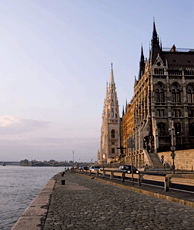 High on the fifth floor, where my suitably generic but comfortable room was located, my balcony afforded a view of the small riverside walkway below where several cafes had tables and umbrellas overlooking the Danube and then beyond where the river floated lazily by and in the background Buda’s Castle Hill district rose up from the opposite bank. I also had a clear view of the so-called Chain Bridge a few hundred meters up the river, one of three or four bridges that span the Danube linking Buda and Pest.
High on the fifth floor, where my suitably generic but comfortable room was located, my balcony afforded a view of the small riverside walkway below where several cafes had tables and umbrellas overlooking the Danube and then beyond where the river floated lazily by and in the background Buda’s Castle Hill district rose up from the opposite bank. I also had a clear view of the so-called Chain Bridge a few hundred meters up the river, one of three or four bridges that span the Danube linking Buda and Pest.
After getting settled in the hotel we decided to head out for a bit of an explore up the banks of the river. Walking along the Danube that night as the sun slowly sank behind the north end of Castle Hill and the shadows lengthened across the face of the old Parliament building, I came across a strange and vaguely disturbing monument of iron shoes sitting in pairs at the edge of the river. Most monuments, whether they commemorate misery or good fortune, exist as positive space, a statue in a square, a wall under some leafy trees, a cannon pointing out over a field, but a few, particularly those that commemorate loss, evoke emptiness and anguish through a sculptural negative space.
The iron shoes scattered there beside the river seemed to me a kind of sculptural synecdoche, tiny parts chosen to represent a whole which was forcibly removed from time. 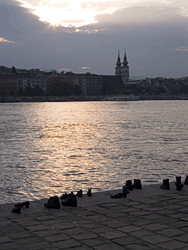 Approaching the shoes scattered on the concrete embankment one does not at first realize they are iron or even a sculpture as the iron is quite blackened and in the fading light of evening they looked as if a group of people simply left their shoes for an afternoon swim. But on closer examination one quickly notices that the styles and cuts of the shoes are outdated and harkened from some moment in the past. But it’s a moment curiously suspended, as if the owners might at any moment climb back up out of the river into which they were cast and reclaim their lost footwear.
Approaching the shoes scattered on the concrete embankment one does not at first realize they are iron or even a sculpture as the iron is quite blackened and in the fading light of evening they looked as if a group of people simply left their shoes for an afternoon swim. But on closer examination one quickly notices that the styles and cuts of the shoes are outdated and harkened from some moment in the past. But it’s a moment curiously suspended, as if the owners might at any moment climb back up out of the river into which they were cast and reclaim their lost footwear.
None of the various guidebooks we were carrying mentioned the monument, but a small plague embedded in the concrete back away from the shoes themselves commemorates the deaths of thousands Jews who were forced into the Danube by the Arrow Cross (Hungarian Nazi Party). What’s most striking about Sculptor Gyula Pauer’s memorial is its quietude in the midst of so many rather loud, larger than life monuments and buildings like the towering pose of the nearby parliament buildings whose Gothic high arches and turrets seemed suddenly overwrought and desperate in their attempt to establish themselves. I thought of how sometimes the quietest statements are the most powerful, the way for instance Nick Drake’s Pink Moon, though almost whispering at times, is one of the most formidable records I’ve heard.
The shoes sitting quietly there on the embankment, very nearly in the shadow of the Margit Island Bridge and so still against the backdrop of the Danube waters reminded me of Newton’s famous analogy comparing the concept of time to the Thames River. 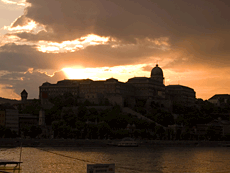 If a substitution of rivers may be allowed, the shoes then seemed to me to perfectly capture a moment, a frozen piece of time which allowed one to circumventing the present through a sculptural trapdoor, to return to something that refused to be swept away by the river.
If a substitution of rivers may be allowed, the shoes then seemed to me to perfectly capture a moment, a frozen piece of time which allowed one to circumventing the present through a sculptural trapdoor, to return to something that refused to be swept away by the river.
I recalled one evening in Cambodia when Rob remarked with some surprise that neither Matt nor Debi nor I had any kind of timepiece between us. And in fact none of us ever had. I don’t know about either of them but I don’t wear a watch. Once some years ago I badly burned my arm with boiling water. Most of the skin on the back of my hand and part of my wrist sloughed off and was cut away by surgeons. By a strange trick of physics the leather band of the wristwatch I was wearing at the time, wicked the water away from my skin before it could be burned. Thus I had a thin band of flesh surrounded by two rather disgusting areas of boiled skin. Eventually of course the burned skin healed, but curiously, the skin where my watch had been remained several shades lighter than that of the burned areas. In spite of the fact that the watch ostensibly saved my skin, it was that protected portion that looked out of place in the end. I decided then that I would never wear a watch again.
How I translated a burn and bit of discolored skin into an intense dislike of mechanical time is something I can’t quite explain except to say that perhaps noticing what was not on my wrist suddenly made me keenly aware of other things that also were not there. Eventually the whole concept of time came to seem too arbitrary to me. Morning, evening, spring, fall these words evoke things, numbers require second hand translation and seem to me a wasted effort.
Later that evening after dinner I sat for a while outside on the balcony smoking cigarettes and contemplating the nightscape of Castle Hill which rose up out of the shimmering Danube waters. The drone of car horns in the distance and the electric 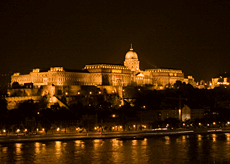 tram squealing out of the station filled the evening air. A riverboat slowly churned up river with a handful of tourists pointing cameras back toward the banks, capturing moments of time, moments they will likely playback later for family and loved ones who were not there. I sincerely doubt if any of them will ever say “this was taken at 7 pm on May 10th.” Instead they will likely say this was our first evening in Budapest, this was the night we sailed along a river, and this was where we walked, danced and swam.
tram squealing out of the station filled the evening air. A riverboat slowly churned up river with a handful of tourists pointing cameras back toward the banks, capturing moments of time, moments they will likely playback later for family and loved ones who were not there. I sincerely doubt if any of them will ever say “this was taken at 7 pm on May 10th.” Instead they will likely say this was our first evening in Budapest, this was the night we sailed along a river, and this was where we walked, danced and swam.
We set out early the next day to explore the Castle Hill area which is the oldest part of the city. The name Castle Hill fails to encapsulate the area. The left side of the hill is actually a palace where the kings once ruled and now stand several museums. The right side of the hill, still encircled by the castle walls contains Buda’s old town quarter. All total the area is more than a kilometer long and encompasses a small city, referred to now as “old town” since like it or not time is our major marker of space.
Castle hill is a sprawling affair that reminded me somewhat of the similarly sprawling City Palace in Udaipur India. Both occupy the top of reasonable sized hills and both encircle what were once functioning cities. And both were constructed over long periods of time according the changing whims of successive rulers until looking at them today they become a reflection of the changing architectural tastes of their respective cultures.
Which is not to say that these two very different places have much in common beyond being large castles built on hills. When traveling for long periods of time it’s easy to slip into the comfortable notion that one has seen and done certain things that need not be seen or done again. It is in other words easy to feel that if you’ve seen one tree you’ve seen them all. But if that were truly the case we could live the life of lightening bugs and be done with it by sunrise. A beech is not a maple is not an oak is certainly not a white fir, the differences in bark and leaves and roots and scent and shade and a million other things will leap out at you provided you pay attention. The notion that the part can be representative of the whole is popular in postmodernist circles, but take it outside the academic and it quickly shows itself as it is—a failure of the imagination.
I believe that one could pick at random any one object and study it, look at it, feel it, breathe it, hear it and be with it every day for the rest of your life without ever really being able to say that you know it, that you understand it, that it has failed to move you, provoke you or challenge you in some way you weren’t expecting. One of my favorite characters in film is Harvey Keitel’s character in Wayne Wang’s Smoke. Keitel’s character, Aggie, takes the same photograph of the same scene from the same place at the same time every day for ten years and has all the prints in massive photo albums and explains to John Hurt’s character the subtle differences between each. That’s the sort of patience and dedication and love that we all ought to aspire to.
We spent the better part of the morning wandering the castle grounds, the narrow streets of old town and a made brief visit to the Hungarian National Gallery. Eventually some clouds rolled in and after lunch a light drizzle began to fall. My parents decided to head back since they were still adjusting to the time change. 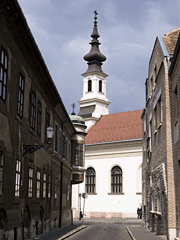 I set out to find the underground passageways that lace the hillside beneath the castle. Most of the area from Budapest south is largely comprised a very porous limestone known as Karst (which, if you’ve been reading this site for while, you may remember also formed the caves I visited in Laos). Over millions of years the water that seeps into the Karst eventually carves out caves and tunnels. The ones beneath Castle Hill in Buda have been slightly improved by man over the centuries and have served as everything from wine cellar to bomb shelter depending on the times.
I set out to find the underground passageways that lace the hillside beneath the castle. Most of the area from Budapest south is largely comprised a very porous limestone known as Karst (which, if you’ve been reading this site for while, you may remember also formed the caves I visited in Laos). Over millions of years the water that seeps into the Karst eventually carves out caves and tunnels. The ones beneath Castle Hill in Buda have been slightly improved by man over the centuries and have served as everything from wine cellar to bomb shelter depending on the times.
Today for a modest fee you can wander through a labyrinth of damp tunnels with dim lights and faux cave paintings in what I believe is supposed to give you taste of Neolithic religion and superstition or at least someone’s idea of Neolithic caves, but unfortunately it comes off a little too campy to be all that interesting. It was a nice escape from the rain, but when I emerged out the far end of the tunnel I was craving something a little less Disneylandish.
I set out alone to escape the crowds of Castle Hill and explore the more modern parts of the city. Something in a travel brochure on the airplane had caught my eye and I decided to see if I could find my way to the tomb of Gul Baba a Turkish Whirling dervish 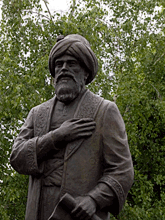 who died in Budapest in 1541. I don’t know much about whirling dervishes aside from the fact that their Turkish in origin and a friend of mine is in a band of the same name (if you’re curious you can visit whirling dervish’s website for more info on the band, but the rumor has it that Gul Baba brought the rose to Buda and the hill on which the tomb rests is known as Rose Hill.
who died in Budapest in 1541. I don’t know much about whirling dervishes aside from the fact that their Turkish in origin and a friend of mine is in a band of the same name (if you’re curious you can visit whirling dervish’s website for more info on the band, but the rumor has it that Gul Baba brought the rose to Buda and the hill on which the tomb rests is known as Rose Hill.
The truth is that while the Dervish tomb appealed to me I mostly wanted to walk through the streets of the real part of the city since the downside to four star travel is that you’re typically sequestered in tourist ghettos, though in Budapest it was more of a business traveler ghetto. In either case you don’t really get to see the everyday life of the locals. So I walked through the rain to the tomb, made a few photographs and ducked into a cafe on my way home for a cup of coffee and bite of Hungarian pastry.
I sat in the back corner of the cafe waiting for the rain to let up thinking of the Hungarian Museum of Fine Art. For the most part there was little of note. The only highlight outside the Spanish gallery of El Grecco and Goya was a single piece from Gauguin’s period in Tahiti. I don’t recall the name of the painting, 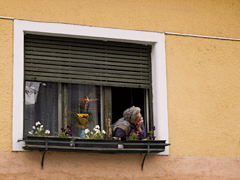 it wasn’t very large, but the vibrant colors and almost overwhelming sense of passion and life made it fairly leap off the wall next to more muted Monet’s and Picassos. Gauguin paid attention and he loved what he saw. His fascination with color seems to have eclipsed nearly every other concern in his mind. Figures are vague as if transitory and chiefly memorable for the light they reflect, background and foreground blend, what matters is not the precise place, nor the precise time, but the color, the color of the world that distinguishes not between only shade and tone and hue and tint to reveal the kaleidoscope that is always all around us.
it wasn’t very large, but the vibrant colors and almost overwhelming sense of passion and life made it fairly leap off the wall next to more muted Monet’s and Picassos. Gauguin paid attention and he loved what he saw. His fascination with color seems to have eclipsed nearly every other concern in his mind. Figures are vague as if transitory and chiefly memorable for the light they reflect, background and foreground blend, what matters is not the precise place, nor the precise time, but the color, the color of the world that distinguishes not between only shade and tone and hue and tint to reveal the kaleidoscope that is always all around us.
Thoughts?
Please leave a reply:
All comments are moderated, so you won’t see it right away. And please remember Kurt Vonnegut's rule: “god damn it, you’ve got to be kind.” You can use Markdown or HTML to format your comments. The allowed tags are
<b>, <i>, <em>, <strong>, <a>. To create a new paragraph hit return twice.